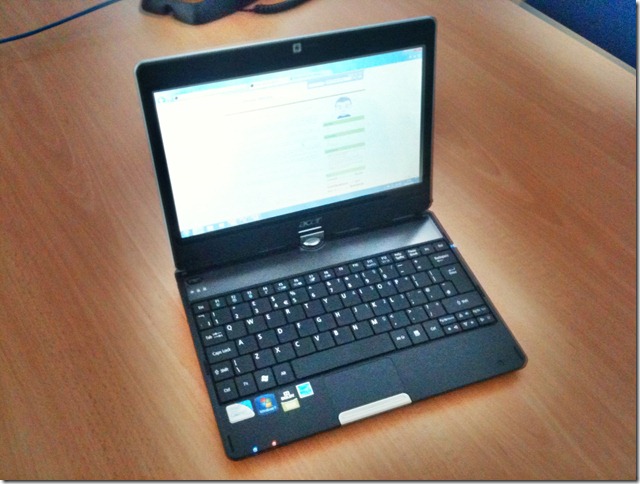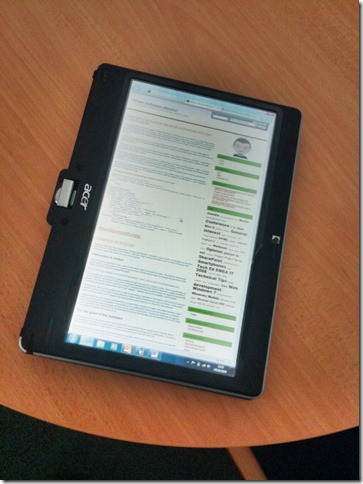Living with the Acer Aspire 1420P
This blog has been a very quiet place for a long time now, reflecting somewhat how busy I have been elsewhere. During this period of heavy work I have found a new friend in my Aspire 1420Tp In some ways it’s sad – my trusty and reliable Dell Mini 9 has been neglected in favour of a younger, sexier model.
The 1420P is the production model Acer convertible tablet, a variant of which was given to all Microsoft PDC conference attendees last year. We have quite a few in the office; sadly I am the only person to have paid for theirs. However, I benefit greatly from the fact that mine has a UK keyboard with all the right keys in their correct and proper places.
Personally, I think you get quite a lot for your money. For about £400 I have a lightweight, highly portable machine with ample power to perform the daily chores I give to it. I will admit that the first thing I did upon taking it from its box was to add a further 2Gb or RAM to its shipping quota of 2Gb, but many will not find the need to do so.
I thought long and hard before purchasing the 1420. I already have my workhorse laptop – the excellent TravelMate 6593 – which runs the things I need for the more technical aspects of my working life. However, it’s 15.4” frame weighs heavy when doing light work on the sofa in an evening, and it’s not great for casual web browsing.
I was finding myself more and more using my iPhone for casual web browsing, email reading and research. It was far easier than having a laptop on my knee, browsing with the touchpad and keyboard. I was seriously considering an iPad – the slate form factor and extreme usability were attractive. I had an eye on the HP Slate so loudly trumpeted b Steve Ballmer before it vanished frustratingly from view.
There were two problems with the iPad approach: Firstly, being a Yorkshireman, I found the price a little steep for an iPhone on steroids; secondly, and not unrelated to my opinion of the price, it was not as functional and flexible as I wanted.
The 1420P meets my needs ably. For casual web browsing, research and email it spends most of its life in tablet form, running portrait mode as I browse the web using nothing but the touch screen. When I use it for document writing or bits of sysadmin work it turns easily back to a traditional notebook form factor.
It’s not perfect. The techy in me wishes that the touch screen was more than a mere 2-point variety; it would be nice if the display was a higher resolution than the now ubiquitous 1366x768, but that’s possibly because I am spoiled by the magnificent 1650x1080 of my TravelMate; the lack of a docking station connector makes it less convenient for use as a workhorse office computer; and it suffers in comparison with the iPad in terms of user interface for touch alone (this isn’t really the fault of the hardware, I suppose).
It’s qualities far outweigh the shortfalls, however. It weights almost nothing, and I can comfortably get eight hours from a full charge which means that the charger (itself small and lightweight) becomes an optional extra for short trips. The glossy screen is bright and clear (although like all glossy screens it suffers in bright light) and does not suffer like the Dell Mini when browsing the web; the keyboard is comfortable and responsive to use and causes me no trouble when working on long documents; finally, and my favourite part, when in tablet mode it is comfortable to hold and natural to use.
Which brings me to something I find really significant about convertibles. When I’m in a meeting I hate using a laptop. I find that the screen immediately forms a barrier between participants and I hate thinking that behind that barrier the person could be doing something other than concentrating on the x7686meeting. I prefer to use a pen and paper as a result, but that means I need to transcribe notes later. The convertible 1420 allows me to switch to tablet mode and use OneNote and the stylus. I have all the benefits of a computer in front of me so I can access documents, email and other resources on demand, but the computer does not come between me and the other attendees. OneNote also allows me to quickly generate notes, tasks, actions and more without leaving the application.
Specification:
Size
285 x 208.9 x 28.5 mm
Weight
1.72kg
Screen Resolution
1366x768
Multi-touch
2-point
Processor
Intel Celeron U2300
Memory
2Gb (upgraded to 4Gb)
Hard drive
160Gb
Price
approx. £400

